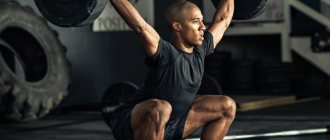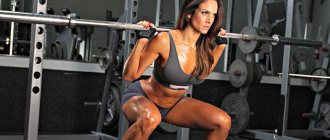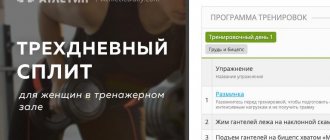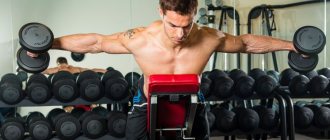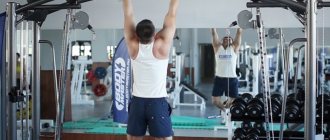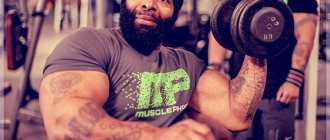Not only women, but also men take care of their figure. They go to the gym to achieve different goals, from losing or gaining weight to building muscle mass. Taking into account these and other parameters, a training program is drawn up that increases the effectiveness of training in the fitness center.
If you want to pump up your body quickly and efficiently, stay with us. We will tell you what a training program for men in the gym is, how it is compiled, and what to pay attention to.
How to train correctly in the gym for a man
Massive and lean muscles, great strength and a wide upper body are characteristic of men, and all this is thanks to testosterone. It is better to perform in the gym those exercises that promote the synthesis of your own testosterone, namely basic ones. This type of exercise should be the basis of every workout. Highly effective exercises for men's training will be those using free weights and those that allow the use of large working weights, for example, in simulators.
Of course, you cannot ignore cardio exercise, however, this type of training should be a small part of the time. Use a treadmill or exercise bike at the beginning of your workout to adapt your body to the upcoming strength load.
The number of workouts should be chosen to be minimal, and when a certain level is reached, increase the number of sessions. Three to four workouts per week are considered optimal. This approach is due to the fact that after a heavy load the body needs more time to recover.
Three day split
A three-day split is one of the most popular training systems, which makes it possible to combine muscle groups so that the athlete can work on each muscle in one circuit, and they have time to achieve supercompensation.
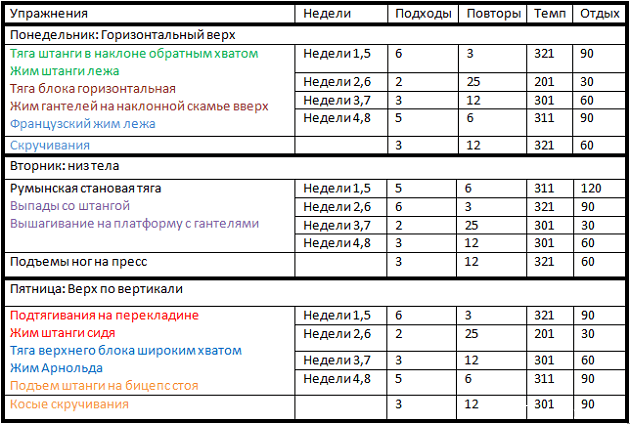
It is important to correctly cooperate between muscle groups in order to achieve the proper result. Basic split rules:
- In one session you need to train one large and one small muscle group.
- Combine muscle groups so that they are antagonists.
Experts recommend simultaneously training chest + biceps or back + triceps + legs + shoulders. A large muscle group should be trained at the beginning of the session, and a small one at the end.
This training scheme is suitable for both professionals and beginner athletes. The bottom line is that as your mass increases, muscles begin to regenerate more slowly, which is absolutely normal - the larger the muscle in volume, the more time it takes to recover.
Bodybuilding involves a constant increase in load, since this is the only opportunity to activate the hypertrophy of muscle fibers. In order for an athlete to increase weight in the barbell, it is recommended to exercise at the moment of supercompensation - this is what makes it possible to progress, thanks to which the split system works.
Weekly gym workout plan
Day 1: chest and triceps training
The most effective exercises for chest training will be exercises with free weights, for example, various barbell and dumbbell presses. It is imperative to include stretching exercises in the training process, such as dumbbell flyes or crossover exercises, as well as a pullover.
Here is an example of a chest workout for men:
- Bench press on a horizontal bench.
- Incline dumbbell press.
- Bringing your hands together in a crossover.
- Pullover.
- French press or dips.
- Arm extensions in the upper block.
- Twisting.
Day two – training the back and biceps muscles
The best and most effective exercises for developing back muscles are pull-ups and various rows, such as T-bar rows, barbell or dumbbell rows, and rows on a lever machine. Additional exercises can be vertical pull-downs and horizontal pull-downs. Also, an alternative to additional exercises can be dumbbell rows with emphasis.
Here is an example of a back workout in the gym for men:
- Pull-ups with different grips.
- Rows in a lever machine.
- Pull a horizontal block to the belt.
- Hyperextension.
- Barbell curls.
- Seated dumbbell curl.
Day three – training the leg and deltoid muscles
In addition to the classic scheme (3-4 sets and 8-12 repetitions), you can use another option, however, it is more suitable for athletes who already have experience training in the gym using the classical scheme. The second option is to increase the working weight, but reduce the number of repetitions . Lifting heavy weights increases testosterone production, and since the largest muscles are concentrated in the lower body, this scheme is very relevant when working on the muscles of the legs.
Basic exercises with compound weights are also the best for training legs, but machines that allow you to use large weights should also be included in the training process. On this day, the athlete also works on the deltoid muscles. Highly effective exercises are vertical presses of dumbbells and barbells, as well as swings and lateral raises with dumbbells.
Here is an example of training legs and deltoids for men:
- Squats with a barbell or leg press in a machine.
- Lunge gait with dumbbells or lunges in a Smith machine.
- Leg curls in a machine or Romanian deadlift.
- Various exercises for the lower leg muscles (calf raises in a Smith machine, calf raises in a sitting or standing machine, raises with dumbbells).
- Seated vertical dumbbell press.
- Front dumbbell swings.
- Dumbbell rows on a bench for the rear deltoids.
How realistic is it to create a working training program without advice from a trainer?
The answer is real. But this requires good theoretical knowledge, supported by experience. You need to know human anatomy, the biomechanics of human body movements, and the anatomy of exercises in the training cycle. It would be a good idea to read a school course on the biology of the human body. In addition, you should definitely know and be able to perform all exercises with the correct technique in order to avoid injuries. If you doubt yourself, consult sports doctors and experienced trainers.
You have the knowledge – which goal to choose?
To choose the optimal goal, you need to know what type of body structure you have.
There are 3 types:
- endromorph (lots of fat and lots of muscle, dense, stocky type);
- mesomorph (quite a small amount of fat, but well-developed muscles);
- ectomorph (minimal fat, little muscle, thin).

It is very difficult for ectomorphs to gain muscle mass, but they have a predisposition to burning fat. Such people are suitable for mass and strength training programs. Mesomorphs are the luckiest people. They have an optimal structure. From birth, it is not a problem for them to gain muscle mass and strength or lose weight and increase endurance. Endromorphs are predisposed to obesity, so the optimal training for them is fat-burning, with minimal loss of muscle and strength.
Any type should not constantly focus on one goal, as stagnation (stopping progress) may occur. Let me add that there are almost no types of people ideally suited to the description above, almost all are mixed, for example, ecdomorph and, at the same time, mesomorph; mesomorph and endomorph.
Now that you have become familiar with the theory, you should choose your initial goal:
- weight gain;
- increase in strength;
- pumping endurance (both muscular and cardiovascular);
- burning fat.
It is worth explaining the difference between muscular and cardiovascular endurance (in common parlance – respiratory endurance). Breathing endurance involves working with light weights, but for a large number of repetitions. In this case, strength indicators will hardly move up. Suitable for cardio cycles (increasing running time, etc.).
The muscular one is also aimed at increasing the number of repetitions, but with a weight close to the maximum. Here's an example of muscular endurance: with a maximum bench press weight of 100 kg, an athlete can do 6 sets with a weight of 90 kg for 5-6 reps each set.
Now it’s worth clarifying some of the nuances of losing weight. Most people are confused by the question “Have you lost weight? But what exactly have you lost most of: fat or muscle?” After all, you can lose weight either by burning fat or by destroying muscle. Or combining these options.
You can, of course, burn fat without losing precious muscle mass, but to do this you need to maintain a strict sleep/diet regime, plus, in addition, consume protein and branched chain amino acids (bcaa). The same nuance, but on the contrary, when gaining weight. That is, weight can be gained from fat or muscle. To gain lean muscles, you need to follow the same tips as described above: take sports nutrition and eat right.
Recommendations for strength training in the gym
Training for men is a set of energy-intensive, heavy exercises that require a sufficient amount of energy and strength to perform. Only a proper diet and proper rest will help an athlete train as effectively as possible, so much attention should be paid to a balanced diet rich in proteins, fats and carbohydrates. The ideal option would be to eat multiple meals throughout the day, for example, five to six meals.
And also read how to eat before and after training.
Sports nutrition is an effective aid in achieving results. It should be chosen based on body composition, but sports supplements such as amino acids and protein will not hurt anyone, and you can also consider taking pre-workout cocktails in the future. Sports nutrition is best used as a means to close the protein-carbohydrate window after training and in the morning, immediately after sleep. It can also be used in cases where a full meal is not possible.
Another important point is proper rest after training. The recovery process lasts from two to ten days, so it is best to distribute training so that after the load the muscle group has the opportunity to rest for at least six days.
How to continue training in the gym
Everything listed above is information for those who are at the beginning of their sports journey. Subsequently, the load should be gradually increased, for example, in addition to the fourth training day and adding approaches and exercises, you will need to resort to changing the type of load to remove the body from comfortable conditions. For example, include exercises aimed at developing strength in the training process, or diversify the process with high-intensity CrossFit exercises.
In the future, the training process can be changed to a five-day training scheme, in which one muscle group is worked out in one workout. In fact, not many professional athletes use this option. In fact, such training may not be effective for all athletes and, most often, it is used by those athletes who use pharmacological agents to achieve results. After all, despite training just one muscle group, the number of exercises and their intensity does not decrease, which will sooner or later lead a follower of natural bodybuilding to overtraining.
How to eat healthy
- First, you should eat small portions, 6-7 times a day. This promotes long-term saturation of the body, eliminates overeating, and maintains the energy needed during training for as long as possible.
- Secondly, exclude unhealthy and fatty foods from your diet. It destroys intestinal flora, blocks the production of testosterone (the hormone responsible for muscle growth) and increases cholesterol, which contributes to fat gain.
- Thirdly, separate food with slow and fast carbohydrates. Products containing complex carbohydrates have the least amount of harmful additives. Complex carbohydrates take a long time to digest in the body, which contributes to a prolonged feeling of fullness and energy production. Examples of such products: buckwheat porridge, brown rice, durum wheat pasta, legumes, fruits, berries, vegetables, herbs. Fast carbohydrates provide energy and a feeling of fullness for a short period, so you want to eat more often.
- Fourth, eat foods high in protein. This is meat. The greatest amount of protein is found in chicken breast, fish, beef and pork, and chicken eggs.
- Fifth, consume sports nutrition. Consult sports doctors and trainers for more details.
